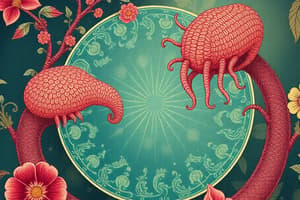Podcast
Questions and Answers
What is the primary mode of reproduction in single-celled organisms like Amoeba and Paramecium?
What is the primary mode of reproduction in single-celled organisms like Amoeba and Paramecium?
- Binary fission (correct)
- Encystation
- Budding
- Sexual reproduction
What is the process called when Amoeba forms a protective cyst around itself under unfavorable conditions?
What is the process called when Amoeba forms a protective cyst around itself under unfavorable conditions?
- Budding
- Sporulation
- Encystment (correct)
- Fragmentation
What is the mode of asexual reproduction in yeast?
What is the mode of asexual reproduction in yeast?
- Budding (correct)
- Fragmentation
- Sporulation
- Binary fission
What is the process called when a single-celled organism like Amoeba divides by multiple fission to produce many daughter cells?
What is the process called when a single-celled organism like Amoeba divides by multiple fission to produce many daughter cells?
Which of the following is an example of asexual reproductive structures in plants and animals?
Which of the following is an example of asexual reproductive structures in plants and animals?
What is the role of mitosis in asexual reproduction of single-celled organisms?
What is the role of mitosis in asexual reproduction of single-celled organisms?
What type of reproduction involves the participation of two parents and the fusion of male and female gametes?
What type of reproduction involves the participation of two parents and the fusion of male and female gametes?
In asexual reproduction, offspring produced by a single parent are likely to be:
In asexual reproduction, offspring produced by a single parent are likely to be:
Which term is used to describe individuals that are morphologically and genetically similar due to asexual reproduction?
Which term is used to describe individuals that are morphologically and genetically similar due to asexual reproduction?
What process is illustrated in Figure 1.2 (b) with Amoeba undergoing division?
What process is illustrated in Figure 1.2 (b) with Amoeba undergoing division?
Which type of reproduction results in offspring that are exact copies of their parent?
Which type of reproduction results in offspring that are exact copies of their parent?
What is responsible for creating genetic variation during reproduction?
What is responsible for creating genetic variation during reproduction?
In organisms with a haploid parent body, which process is responsible for the production of gametes?
In organisms with a haploid parent body, which process is responsible for the production of gametes?
Which type of reproductive division is necessary for a diploid body to produce haploid gametes?
Which type of reproductive division is necessary for a diploid body to produce haploid gametes?
Which type of organisms are more likely to have a diploid parental body according to the text?
Which type of organisms are more likely to have a diploid parental body according to the text?
What is the significance of meiosis in the life cycle of organisms?
What is the significance of meiosis in the life cycle of organisms?
Which process ensures that a diploid body can produce haploid gametes?
Which process ensures that a diploid body can produce haploid gametes?
What type of division is responsible for the production of gametes in organisms with a haploid parent?
What type of division is responsible for the production of gametes in organisms with a haploid parent?
Flashcards are hidden until you start studying
Study Notes
- Gametes are haploid, even though the parent plant body can be haploid or diploid. A haploid parent produces gametes through mitotic division.
- Meiosis, the reduction division, must occur in organisms with a diploid body to produce haploid gametes.
- Organisms like monera, fungi, algae, and bryophytes have a haploid plant body, while organisms like pteridophytes, gymnosperms, angiosperms, and most animals have a diploid parental body.
- Asexual reproduction is common in single-celled organisms, as well as plants and animals with simple organizations.
- Clones are genetically identical and morphologically similar individuals produced through asexual reproduction.
Studying That Suits You
Use AI to generate personalized quizzes and flashcards to suit your learning preferences.




